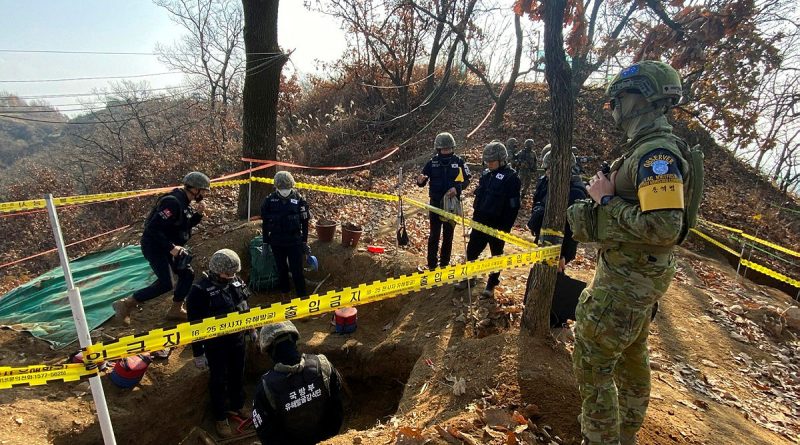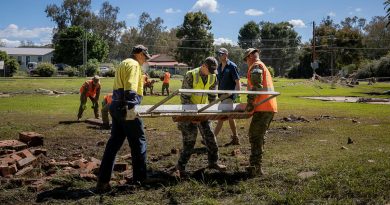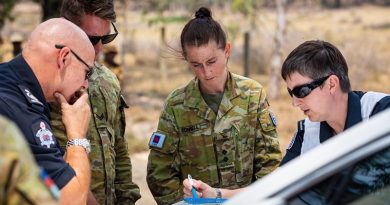Aussies help on Korean DMZ battlefield excavation
Share the post "Aussies help on Korean DMZ battlefield excavation"

The White Horse Hill battlefield is silent, yet decades on it remains contested and dangerous.
CAPTION: Australian observer Leading Aircraftman Ben Whitfield, right, observes personnel from the Ministry of National Defense for Killed in Action Recovery and Identification conduct human remains recovery at White Horse Hill. Story and photo by Petty Officer Jason Wilson.
There are signs of recent activity, but now the ground is too frozen to dig. The Korean War battle site remains silent, waiting for the spring thaw and the chance for searchers to return to find more remains of the fallen.
In September 2018, North and South Korea signed a comprehensive military agreement, which included a plan to transform the demilitarised zone (DMZ) that separates the two Koreas into a “peace zone”.
This has allowed South Korea to search for human remains within the DMZ and carry out explosive-remnants-of-war disposal.
This work is undertaken during the warmer months of the year, as the ground freezes in winter making excavation too difficult for the delicate work.
Among the uniforms of South Korean service personnel and government agency workers at White Horse Hill in 2022 could be seen those of Australian Defence Force personnel.
Australia deploys four members twice a year under Operation Linesmen, the ADF’s contribution to the inter-Korean peace process, deployed at the request of the United Nations Command (UNC) to support the work in the DMZ.
As part of the UN Command Military Armistice Commission, the four-person team provides three observers to ensure tasks conducted within the DMZ are monitored and are in accordance with the terms laid out in the Korean Armistice Agreement of 1953.
The fourth member is a mine action staff officer.
In 2022, the Australian team operated at White Horse Hill, located inside the four-kilometre-wide DMZ just north of the provincial township of Cherwon.
Linesmen Rotation 8 members observed the de-mining and remains recovery operations being conducted by the Republic of Korea Army (ROKA) 5th Infantry Division and the Ministry of National Defense for Killed in Action Recovery and Identification (MAKRI).
Australian contingent commander Flight Lieutenant Joon-Hee Wang, who speaks Korean, provided valuable assistance to the mission.
She said Operation Linesmen was an important component for upholding the agreement against a backdrop of military tensions between South and North Korea.
“White Horse Hill was the site of a bloody battle between the ROKA 9th Infantry Division and Chinese People’s Volunteer Army (PVA) 38th Corps, fought during October 1952,” she said.
“Possession of the hill changed hands 24 times and resulted in thousands of casualties due to an intensive bombardment campaign by ROKA, PVA and the United States Air Force.
“The establishment of the DMZ meant the site has been frozen in time, and it is only now that major battlefield recovery efforts can get underway.”
During Rotation 8’s tenure, MAKRI recovered many remains of ROKA and PVA personnel.
The remains were ceremonially removed from the battlefield and taken to MAKRI laboratories in Seoul, with Chinese remains repatriated to China. The Korean remains were examined using a DNA database, which enabled identification and reunification of those killed in action with their long-bereaved families.
The ADF team’s deployment also included an opportunity to visit MAKRI headquarters in Seoul, where they were shown the process of identification and reunification of those killed in action.
Australian contingent translator Leading Aircraftman Ben Whitfield said the recovery and repatriation process was an emotional journey for all involved.
“The closure given to the families and the satisfaction felt by MAKRI made this deployment honourable and memorable for the Australian team,” he said.
At White Horse Hill, the earth still clings to many names and memories.
While the remains of 45 missing in action soldiers were removed from the hill in 2022, the project has many years ahead of it, with the number of missing soldiers from ROKA and PVA possibly running into the thousands.
Seventeen thousand Australian troops served in the Korean conflict, with 340 killed and 1216 wounded.
Two hundred and eighty-one lie with thousands of their UN allies in the United Nations Memorial Cemetery at Tanggok, in Busan, South Korea, while another 10 are buried at the Yokohama War Cemetery in Japan. 44 Australians remain missing in action.
.
.

.
.
Share the post "Aussies help on Korean DMZ battlefield excavation"





